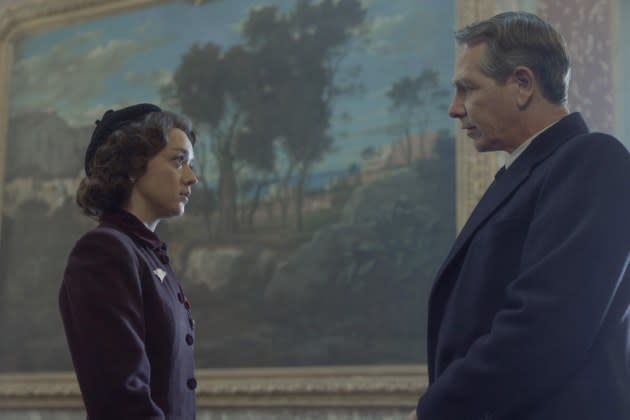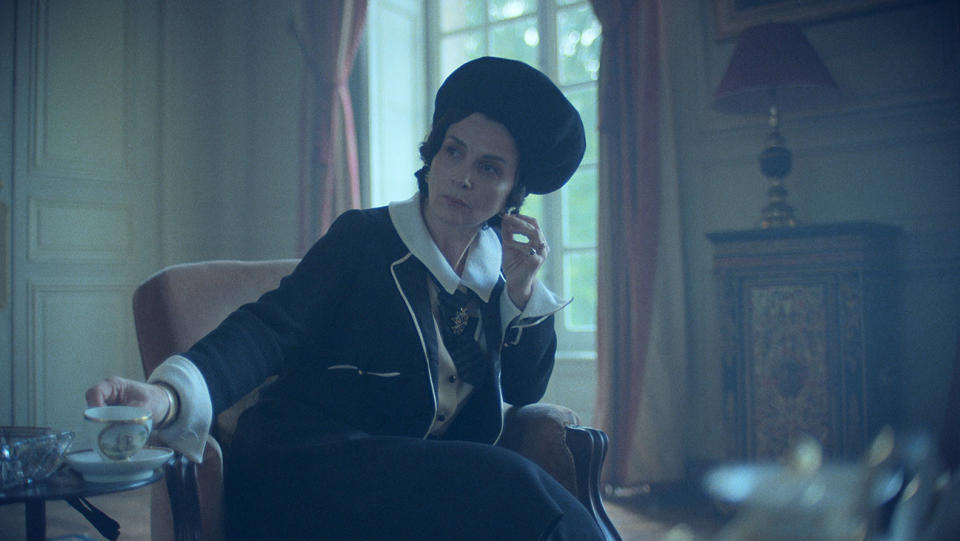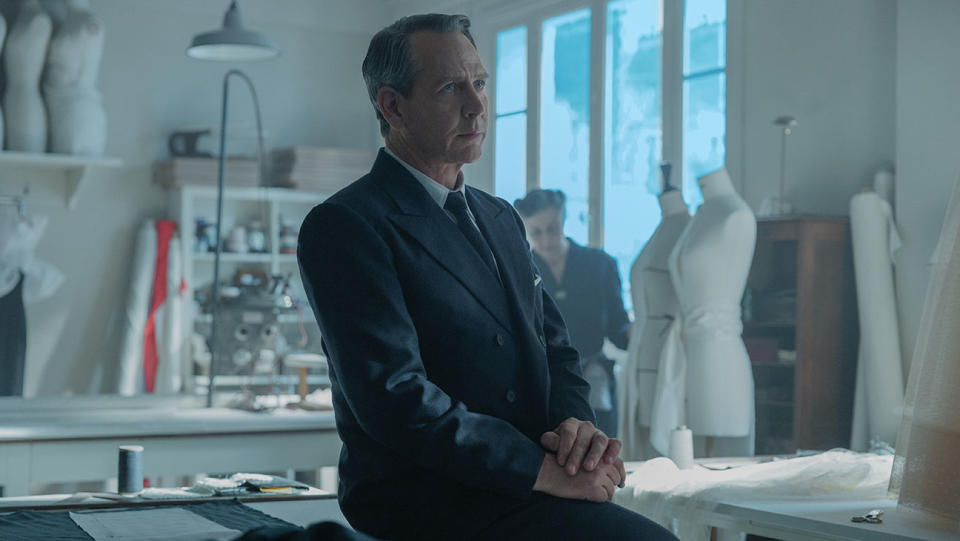‘The New Look’ Boss Says Finale Isn’t the End for Dior, Reveals Potential Season 2 Plans and Beyond
- Oops!Something went wrong.Please try again later.
- Oops!Something went wrong.Please try again later.
- Oops!Something went wrong.Please try again later.
- Oops!Something went wrong.Please try again later.

[This story contains spoilers from the first season of The New Look.]
The first season of Apple TV+’s The New Look ends with Christian Dior (Ben Mendelsohn) debuting his revolutionary 1947 collection that would be dubbed “the new look” by Harper’s Bazaar editor-in-chief Carmel Snow (Glenn Close). The show then quickly flashes forward through some of the Dior brand’s iconic looks over the decades, which seems to suggest that the series is done with Dior’s story.
More from The Hollywood Reporter
Elisabeth Moss, Kerry Washington to Star in 'Imperfect Women' for Apple
Catherine O'Hara, Kathryn Hahn Among Cast Joining Apple's Seth Rogen Comedy 'The Studio'
But creator Todd A. Kessler tells The Hollywood Reporter that he has a long runway planned for the series, which has yet to be officially renewed for a second season. A potential season two would continue to focus on Dior and Coco Chanel (Juliette Binoche) before subsequent seasons would stay with the Dior brand as it was inherited by Yves Saint Laurent.
“I read that in the press, and that was the first time that I had ever heard of it as an anthology series,” Kessler says of his plans for the show to continue. “As with the other series that I’ve created in Bloodline and Damages, we begin with the notion that it could go five or six seasons. So this series would follow the life of Christian Dior.”
Kessler points out that Snow anointing Dior’s collection hasn’t yet happened onscreen, and that that would take place in season two, which would also follow the French designer in America.
“You would then follow Christian Dior in his tremendous, overnight, unprecedented success in the second season, and what actually befalls him, how he deals with that success,” Kessler shares. “He’s coming to America for the first time. He’s going to Dallas. [Former Neiman Marcus president and CEO] Stanley Marcus, had a fashion awards, and Christian Dior won designer of the year and was brought to Dallas. So you have someone who’s never been out of France, going to Dallas, Texas — your imagination can take you where it might, a Frenchman not understanding the food, not understanding this whole world of Texas. And he was also in New York. So it follows Dior’s life and Chanel’s life.”
Beyond that, subsequent seasons would explore how Dior handed off his eponymous brand to Saint Laurent and fashion houses being run by other people than the brands’ founding designers.
Kessler continues, “And eventually when Dior dies 10 years into his fashion house, which would be potentially in a subsequent season to the second, there’s a hand off to Yves Saint Laurent, who was his protégé, and Dior had trained Saint Laurent from the time he was 19 to 21. And when Dior dies, Saint Laurent takes over Dior, the world’s most profitable, influential fashion house, at the age of 21. And the series would go on to follow the life of Yves Saint Laurent up until the ’80s. And we would then get the deaths of [Pierre] Balmain, [Cristóbal] Balenciaga, Chanel in due time and how the fashion industry, for the first time ever, handed over fashion houses to other designers to design under the name of the founder. So that hadn’t happened prior to Dior dying.”
Going forward, Kessler says he also hopes to reveal more of Chanel’s history as well, to show “how she started and continue to dimensionalize her, because she’s truly one of the most extraordinary people that I’ve ever come across in the 20th century, if not any century.”
Chanel suffers a number of personal setbacks at the end of season one, with the death of her close friend Elsa Lombardi (Emily Mortimer) and her nephew, André (Joseph Olivennes), learning of her Nazi collaboration via Spatz (Claes Bang). André abandons her and reports her behavior, leading to officials arriving to take her back to France.
As for the death of Elsa, which comes as Chanel appears to be accepting her friend as part of her family, Binoche says the designer “must have been destroyed.”
“It was her best friend,” Binoche says of Elsa. “They had the best time together.”

Throughout Chanel and Spatz’s interactions, it remains unclear how much of their dynamic is based on a genuine attraction and how much is based on them using each other to get what they need.
“In our story, there’s a thing of like an attraction that also carries them a bit,” Bang says of Spatz and Chanel’s relationship. “There’s quite a lot of stuff written about it. And it seemed it was not just business, actually. Even when he sort of lured her over to do what they needed, there’s still something going on with them. We tried to put that in there, that they actually had a quite twisted relationship because it wasn’t just business, they got quite attracted to each other.”
While viewers see throughout the series what Chanel says about Dior, beginning with her early proclamation that Dior “ruined French couture,” Dior’s feelings towards Chanel remain more concealed, which Mendelsohn indicates was part of how he thinks Dior conducted himself.
“I think he would talk privately with Jacques (David Kammenos) and some of his contemporaries about what he felt,” Mendelsohn tells THR. “He has that moment in the Sorbonne where he does this kind of brush-off, avoidant but telling answer, but I do think he’s a little more likely to hold his cards a little closer. He’d probably feel a little uncomfortable depending on the company saying anything, but he’d probably be able to talk to Jacques. He wouldn’t be able to talk to Balmain (Thomas Poitevin). He wouldn’t talk to anyone who had any kind of relation or kinship with her and divulge, but Jacques would know.”
Beyond that, Mendelsohn shares, “I have an idea of what he would feel about her, but putting it in the public space would be taking it away from the audience, where I’d prefer it be.”
As the first season explores what its real-life characters do to forge ahead amid the trauma of World War II, Dior’s own survival instincts shift as he goes against his rule not to hire seamstresses from rival designers in order to meet his deadline.
“I think the series is about one’s idea of one’s morals and what one will do or won’t do in abstract, and then you run into reality,” Mendelsohn says. “And then I think once you run into reality, these kind of moral positions or these ideas of ourselves or these concepts of what we can and cannot do, they meet reality. And when you meet reality you must respond to reality. And if you can’t respond to reality then you’re fucked, perhaps. I think at that point if he can’t respond to it, as uncomfortable as it is in the short term, it doesn’t detract from the fact that that’s still the guy he is. It was just a case of do I hoist myself on my own petard for this notion that I’m a guy that won’t step on anyone’s feet at any time? Or do I survive and get this fashion house up? And there really is no argument — it has to be done.”
Kessler adds, “For anyone running their own business, in Dior and Chanel, specifically, in this example, they’re constantly put to the test. What choices will you make when you’re confronted with: You need seamstresses to open your fashion house and your only opportunity is to take them from your friends? And that’s breaking the rules, but otherwise you will fail. And what does it actually mean? So at every moment in life, there are these tests and at every moment, as someone who’s leading their own business as someone who is trying to survive, you are defining who you are by those choices that you’re making.”

The World War II-centric first season has come out during a crucial election year in the U.S., featuring a number of prominent, far-right-backed candidates, including presumptive Republican nominee Donald Trump.
And Kessler is hopeful people can look to history to better understand the present.
“There’s nothing, maybe very little if anything, that we’re going through today that people haven’t experienced in the past in some way or form,” Kessler says. “So to benefit from those experiences and what really attracted me and many other people to this subject matter was there’s a lot to think about in other people’s lives that they’ve lived and choices that they’ve made and how they reflect on the lives that we’re living and choices that we’re forced to make.”
Executive producer Lorenzo di Bonaventura adds that he hopes the show might temper people’s immediate, harsh judgments.
“What’s remarkable about what I experience today is how much people are judging each other. ‘You’re a lib. You’re a MAGA.’ And the disdain that we have for one another on that level is really not a healthy place to be,” di Bonaventura says. “The reflection of the show is going back to what would you do to survive? Maybe it’ll soften people, [and lead to them saying,] ‘You know what, I’m not going to be so quick to judge these people. They did what they could.’ We’re so judgmental right now. And I hope maybe that’s something that can come out of this.”
While the first season shows Dior launching his own house after Catherine is captured and returns, Mendelsohn is careful to argue that he doesn’t think Catherine’s fate and Dior’s concerns about his sister necessarily affected him as a designer.
“I think it affected him as a person,” he says. “My guess is that it didn’t affect him as a designer except perhaps to dial in what he wanted Miss Dior perfume to be. I think it definitely affected that. It affected that perfume, and that perfume was not seen to be a good idea to launch at the same time as the collection. It definitely affected that he was going to release that fragrance at the same time as he was releasing that collection. And that fragrance is all about that garden and so are the clothes. So he got Catherine back now let’s go back and be back with mom in the garden back at that time. I think it probably crystallized that. But I don’t know if it changed him.”
And specifically, though viewers see Dior take the steps to launch his own house after he believes Catherine won’t return, Mendelsohn says there’s a much simpler reason for him taking this business opportunity.
“The thing that made him take a leap is some venture capitalist was out looking for opportunities and Dior was a good opportunity,” Mendelsohn says. “It’s the fact that someone has spotted him and there’s an opportunity there. I don’t think Dior would have done anything about it, personally. I don’t think he would’ve gone out shopping himself out. He was head-hunted and he knew if he could do the jump now’s the time to do the jump. If not now, then when, and he went for it. I think he would’ve done it regardless of what the other situations were only because the opportunity was there and he was hunted.”
The season one finale ends with Bleachers performing “It’s Almost Like Being in Love,” capping Jack Antonoff’s first-season curation of early to mid-20th century songs performed by modern-day artists.
“I wanted to think of people who have voices that are old and new, like Florence [Welch] or Nick Cave or Lana [Del Rey],” Antonoff tells THR about his approach to selecting the performers for the cover songs that end each episode. “A big thread of how I was imagining this was people that at once vocally they could be from 100 years ago or 100 years in the future, like there’s a large rubber band but you can’t really place it. That was my whole goal with the soundtrack, even using a certain amount of wood instruments so the low end is a little more synthetic, so it’s kind of modern and dark within all of those old sounds. The voices kind of had to be the same thing, like they pull you into different time periods.”
Composer James S. Levine also worked to meld his score with Antonoff’s song choices.
“I had written these bigger themes and tone pieces so we could establish what some of the bigger character themes were going to be,” Levine says. “And then, once the songs were chosen, I’d kind of do my own recordings of sections or parts and fracture those so they kind of start merging with the original themes that I had written and lay like breadcrumbs leading up to the song at the end of each episode. So that’s kind of a technical, artistic thing that we aim to do with each episode, where one section of the song or two notes might play or the answer to that phrase in the song might play, and then they gradually start merging, so by the time you reach the conclusion of the episode, it can go from one of my themes into the song that Jack produced.”
And like Kessler, Antonoff already has ideas for multiple seasons.
“My head’s spinning already,” he says. “This is one of my favorite things I’ve ever done in music. I loved every second of it.”
The first season of The New Look is streaming on Apple TV+.
Best of The Hollywood Reporter
A 'Star Wars' Timeline: All the Movies and TV Shows in the Franchise
'Star Wars': 16 Animated Characters Who Made the Leap to Live-Action
Power Showrunners: Hollywood’s 50-ish Most Influential Writer-Producers of 2023

